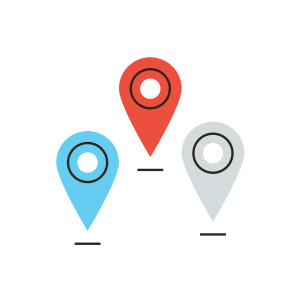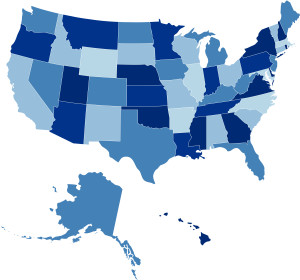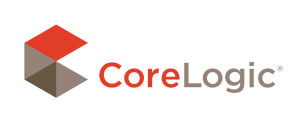This post is part of a series sponsored by CoreLogic.
The Importance of Accuracy and Granularity when Navigating the World of Big Data
When we think about data, all we have to do is look around to see its power at work. Data is everywhere, and it is so seamlessly integrated into every aspect of our lives that we often forget how dependent we are on it and what it does for us, rarely taking the time to consider our lives without it. Just think about all the notifications you receive from your technology—from calendar reminders you have set months, or years, in advance to notifications from your social media  platforms (Facebook, Twitter, Pinterest, etc.). The reality is that we live and breathe data—including data related to location. Data’s ubiquitous nature makes understanding and using it essential to many of our daily activities. For example, are you picking up a friend for dinner? Where do they live? How long will it take to get there? What is the best route to your restaurant? These are all answered with the mapping application on our smart devices. Without the location data that powers mapping applications, how many of us would be literally lost?
platforms (Facebook, Twitter, Pinterest, etc.). The reality is that we live and breathe data—including data related to location. Data’s ubiquitous nature makes understanding and using it essential to many of our daily activities. For example, are you picking up a friend for dinner? Where do they live? How long will it take to get there? What is the best route to your restaurant? These are all answered with the mapping application on our smart devices. Without the location data that powers mapping applications, how many of us would be literally lost?
With “location, location, location” being the cardinal rule of real estate, it is strange to think that it’s often one of the most overlooked elements when considering a property. In the real estate industry, numerous data points exist to provide information on property details. Specific data attributes for properties such as address, owner, structure, assessment and valuation, just to name a few, create an illusion of providing the whole story about a property when, in actuality, it is only part of the story. Only one of these attributes is directly related to the first rule of real estate (location, location, location), and that is the address.
For many, an address is considered to be a precise location, an unequivocal defined point on the earth. Yet, an address is distinguished as a way to catalogue and identify a particular geographic whereabouts, and is actually not representative of the location itself. Instead, an address represents a particular property/building, on a particular street, in a particular city, in a particular state. Yet in isolation, it provides very few location details without consulting some other source of information for validation, such as a map. Therefore, we rely on more granular mapping data as a guide to interpret the catalogue of data that the address provides, because close enough just isn’t good enough.
 Granularity is important when considering any form of mapping data. For example, it is highly unlikely that a single page map of the United States would be of much value in helping you navigate from your house to the airport in your city. It would, however, be helpful, in understanding the relationship between California and Florida, i.e., the overall state-to-state proximity. In turn, the more precision necessary, the more granular your data needs to be. When identifying address locations, the most granular information available is found in those datasets that represent geospatial information for the particular parcel of land or structure either via boundary data or geographic point data representing a specific latitude and longitude.
Granularity is important when considering any form of mapping data. For example, it is highly unlikely that a single page map of the United States would be of much value in helping you navigate from your house to the airport in your city. It would, however, be helpful, in understanding the relationship between California and Florida, i.e., the overall state-to-state proximity. In turn, the more precision necessary, the more granular your data needs to be. When identifying address locations, the most granular information available is found in those datasets that represent geospatial information for the particular parcel of land or structure either via boundary data or geographic point data representing a specific latitude and longitude.
Many companies have a business imperative that requires they create and maintain granular and complete location-based spatial datasets to enable and empower their businesses decisions. Parcel data is at the base of many of these decisions for a variety of different industries and provides important foundational elements for Geographic Information Systems (GIS). For companies and organizations that must plan across multiple parcels and geographies, granular GIS data can improve accuracy while streamlining a variety of the processes required. In many instances, these businesses have a wealth of data options available to them. But, not all data is created equal, and users should carefully consider data quality when making any important decisions that are informed by the data source.
The term “big data” gets thrown around a lot these days and there is no shortage of ways to use such data elements for all manner of analysis. All data sources are subject to quality concerns, and this is especially true of location-based information. Creating high quality data that is Complete, Current and Connected™ is never as easy as it seems, and anyone looking to produce their own datasets will quickly discover the job is probably larger than they planned it to be. Those seeking to leverage existing data need to consider carefully the data quality and accuracy to ensure the decisions they make from this data are appropriate and accurate. Navigating the world of big data, and particularly big location data, requires close attention to quality and accuracy, otherwise location, location, location may end up as lost, left-out and looking for more.
Click here for more information on Location Information Solutions from CoreLogic.
About CoreLogicCoreLogic (NYSE: CLGX) is a leading global property information, analytics and data-enabled services provider. The company’s combined data from public, contributory and proprietary sources includes over 4.5 billion records spanning more than 50 years, providing detailed coverage of property, mortgages and other encumbrances, consumer credit, tenancy, location, hazard risk and related performance information. The markets CoreLogic serves include real estate and mortgage finance, insurance, capital markets, and the public sector. CoreLogic delivers value to clients through unique data, analytics, workflow technology, advisory and managed services. Clients rely on CoreLogic to help identify and manage growth opportunities, improve performance and mitigate risk. Headquartered in Irvine, Calif., CoreLogic operates in North America, Western Europe and Asia Pacific. For more information, please visit www.corelogic.com.
Topics Property
Was this article valuable?
Here are more articles you may enjoy.




 Soccer Officials Arrested After Melee That Damaged Hard Rock Stadium in Miami
Soccer Officials Arrested After Melee That Damaged Hard Rock Stadium in Miami  Beryl’s Remnants Spawned 4 Indiana Tornadoes, Including an EF-3: NWS
Beryl’s Remnants Spawned 4 Indiana Tornadoes, Including an EF-3: NWS  Viewpoint: Deepfake Fraud Is On the Rise. Here’s How Insurers Can Respond
Viewpoint: Deepfake Fraud Is On the Rise. Here’s How Insurers Can Respond  Study Urges Rethinking of Disaster Management in Era of Compounding Events
Study Urges Rethinking of Disaster Management in Era of Compounding Events 

